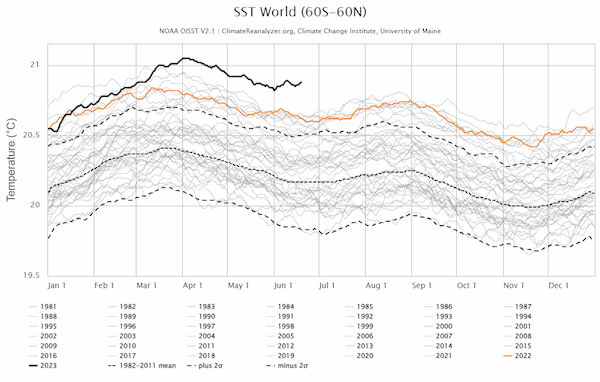This is fine

In 2015, at the UN Climate Change Conference COP21 in Paris, an international treaty was signed. It committed to holding the increase in global average temperature to “well below 2°C above pre-industrial levels”. It also committed the countries signing it to “pursuing efforts to limit the temperature increase to 1.5°C above pre-industrial levels”.
In December 2023, COP28 was held in the United Arab Emirates, the third largest producer of liquid fossil fuels in OPEC. Fossil fuel extraction represents about 17% of the country’s GDP, and they’re still planning to increase production capacity through 2027. The President of COP28 was the CEO of the Abu Dhabi National Oil Company (ADNOC), Sultan Al Jaber. The outcome of COP28: “Today, the Parties agreed a landmark text named The UAE Consensus, that sets out an ambitious climate agenda to keep 1.5°C within reach.”
Two days ago we all got the news: global warming has exceeded 1.5°C for an entire year. We’ve blown right through the target that COP28 was farcically pretending we had any chance of hitting. The oil sultan’s response? “We must urgently implement the roadmap laid out in the UAE Consensus”. Of course, this is the man who previously said “There is no science out there, or no scenario out there, that says that the phase-out of fossil fuel is what’s going to achieve 1.5°C”, so I’m sure his favored plan is fantastic.
When my wife and I moved to Austin, Texas in 2004, we knew it was going to be hot, and it was. July and August were unbearable — times to hide indoors in the air conditioning, or go on vacation somewhere else in the world. But it was only for a couple of months, and then the rest of the year would be OK, mostly.
The year 2011 was different. Austin had 90 days where the temperature was over 100ºF (38ºC), slightly more than double the normal number. Pretty much everything in our yard died except for the cactus. There hadn’t been a heatwave that bad since 1925. The state climatologist said that the high temperatures might continue for 8 years or so before returning to the normal average of 13 hundred degree days a year.
He was wrong. 2013, 2017, 2018 and 2019 all saw 42 or more days over 100ºF.
Then came 2022. That summer saw Austin get as many days over 90ºF (32ºC) as it had in 2011. The heat was unbearable, and it was still hitting 95ºF in the middle of October.
I started to realize that headlines about average temperatures are misleading. They obscure significant changes in the distribution of extreme weather days. I talked to friends who had been in the area longer than us, and as one of them put it, “This is not what I signed up for.”
There’s a measurement called the wet bulb temperature. It’s measured by putting damp cloth over the bulb of a thermometer. If the surrounding humidity is low, the water in the cloth evaporates and cools the thermometer. If the humidity is high, it doesn’t. This is the data used for weather apps’ “feels like” temperatures, which are higher when the air is humid.
The web bulb temperature is important because it accounts for how quickly animals like humans can lose temperature by sweating or panting. In a web bulb temperature of 32-35ºC, the average healthy person can survive for about 6 hours. That temperature is about equivalent to a dry 40ºC, or 104ºF. In Phoenix, it was hotter than that for all but 5 days in August. Dry heat or not, that’ll kill you. In Austin, it hit 102ºF with 48% humidity at the end of August. Just going outside I found myself struggling to breathe in the stifling hot air.
In spite of the deadly heat, Phoenix is the fastest growing metro area in the USA. People live in their air conditioned homes. They walk briskly to their air conditioned cars and drive to work, where they work in an air conditioned office. After work they might go to the air conditioned mall or an air conditioned restaurant.
It’s much the same in Texas for half the year now — with the added excitement that the Texas electrical grid is near collapse the whole time, because it’s designed that way to maximize profits. (Electricity companies don’t make any money by keeping spare capacity online, but they can make out like bandits if there’s a major shortage.)
Meanwhile, society is doing about as well dealing with COVID-19 as it is keeping to climate pledges. Western nations are clearly going to put up with waves of deaths as new variants show up, and more and more people are going to end up with debilitating Long COVID symptoms.
So for half of the year, Texas is a choice between risking your life by going outdoors, or risking your life by going indoors. Being unable to go outside isn’t a major issue if you can go to restaurants, go to live music events, go see a movie, and so on. If you’re stuck in your own house for 4–5 months, though, it quickly becomes a mental health problem, as people found out during the lockdowns of 2020. I realized that Austin was becoming a really bad place to live. For the sake of my health, it was time to look for alternatives.
While we worked on that, 2023 happened, and it was even worse. The temperature hit 100ºF on June 9th, and stayed there continuously for 45 days. At that point it briefly dipped, but soon jumped back up. The last 100 degree day was October 4th. We left Texas 10 days later.
The climate isn’t just a crisis in Texas, of course. In Arizona, it’s now so hot in summer that the cactus have started to die. People’s shoes are melting on the ground. Those who are unlucky enough to fall over outdoors are ending up with severe burns. And in Phoenix, there’s another change in climate patterns that hasn’t received too much attention: it’s not getting cool overnight any more. It’s staying 100ºF or more the whole time. In Florida, ocean temperatures hit 100ºF. I like to relax in a hot tub as much as anyone, but the ocean should not be the temperature of a hot tub.
In August 2023, parts of South America were significantly hotter than the previous summer. Which maybe doesn’t sound so bad, except August in South America is winter. It hit 30ºC in Buenos Aires, where the average is 14ºC. Vicuña in Chile saw temperatures 25ºC above normal.
In June 2023, I start seeing graphs like this one circulating online:

That’s the point at which I really started to get worried. The graph shows sea surface temperature as it fluctuates up and down over the course of a year. Each gray line represents a different year. Each year is slightly higher up the chart than the years before, but the same basic shape. Then suddenly in 2023, the pattern broke.
Now that we’re into 2024, here’s what the sea surface temperature anomaly graph looks like:
The predictions we hear concerning the climate crisis are based on extrapolation. Scientists look at the ongoing trends in the data, and then they try to project ahead by assuming the same patterns will continue. They adjust figures, of course, based on theories about the mechanisms involved in climate change; but fundamentally the predictions depend on extrapolating from current data. But we’ve hit a point where past patterns no longer apply — quite literally a sea change. All bets are off; anything could happen.
In Antarctica, sea ice has reached a record low. If the Thwaites Glacier melts — which it might do in just a handful of years — ocean levels will rise by an estimated 63 centimeters. If the entire West Antarctic Ice Sheet then collapses, ocean levels could rise by 4 meters. Ice loss was already measured as accelerating before 2023’s temperatures.
But we can fix it, right?
Well, we already briefly hit the 2ºC level last year. Last year’s UN Environment Program report concluded that to stay under 2ºC, we need to cut emissions by 28% by 2030. In reality, greenhouse gas emissions are still increasing, with no end in sight. I think there is absolutely zero chance that we’ll cut emissions by more than a quarter in the next 6 years.
But In spite of all I’ve written here, I’m not a doomer. This isn’t a human extinction scenario, and I’m not convinced that societal collapse is inevitable. But the fossil fuel industry knew about the risks of climate change in 1954, and seven decades on we are moving decisively into the Finding Out phase.
Personally, I think it’s a safe bet that we’ll hit 2ºC by 2040. Things are going to get bad, very bad.